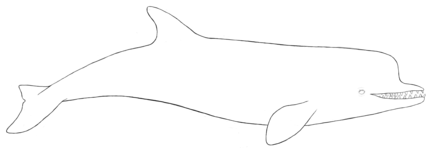Albicetus
| Albicetus | |
|---|---|
 | |
| Reconstruction of skull | |
| Scientific classification | |
| Kingdom: | Animalia |
| Phylum: | Chordata |
| Class: | Mammalia |
| Order: | Artiodactyla |
| Infraorder: | Cetacea |
| Genus: | †Albicetus Boersma & Pyenson, 2015 |
| Species: | †A. oxymycterus |
| Binomial name | |
| Albicetus oxymycterus (Kellogg, 1925) | |
| Synonyms | |
| |
Albicetus is a genus of stem-sperm whales that lived during the Miocene Epoch, around 15 million years ago, and was discovered in Santa Barbara, California in 1909. It was categorized for decades as belonging to a group of extinct walruses erroneously thought to be sperm whales. It was named Albicetus, meaning "white whale," is a reference to the leviathan in Herman Melville's classic 1851 novel Moby-Dick, centering on Captain Ahab's obsession with a huge white sperm whale.[1][2]
Taxonomy
.png)
Etymology
The genus Albicetus derives from the Latin words albus (white) and cetus (whale), and so literally means "white whale". It was named in reference to the antagonist Moby Dick from Herman Melville's novel Moby-Dick. This reference was done both in honor of Melville and as a reference to the most notable traits of the white whale, which includes "unwonted magnitude", light color, and a crooked and deformed lower jaw. These traits coincidentally also describe the traits found in the Albicetus oxymycterus holotype- The fossil itself possess a light hue, represents a large top predator, and has a diagenetically displaced mandible.[1]
The species name oxymycterus is derived from the Greek ὀξύς oxy (sharp) and μυκτήρ mycter (nose).[1][3] Therefore, Albicetus oxymycterus literally means "sharp-nosed white whale".
Taxonomic history
The holotype was recovered from an unspecified location in the sea cliffs near the original Santa Barbara Lighthouse in 1909, which is believed to most likely be part of the Monterey Formation. It was originally placed in the genus Ontocetus in 1925 by Remington Kellogg. However, this was based on an erroneous assumption that the type species of the genus, Ontocetus emmonsi, which was based on a single tusk (which was believed to be a tooth at the time), was that of a physeteroid, which could not be confirmed due to the holotype having been lost.[3] This assignment was followed by later authors, including Barnes (1977) and Hay (1930).[4][5]
In 1994, the holotype of Ontocetus emmonsi was relocated in the collections of the Smithsonian Institution, and in 2008 a comprehensive paper was published demonstrating that the Ontocetus generitype was a walrus, not a sperm whale. Hence, Ontocetus oxymycterus, which was not a walrus, was reassigned to Scaldicetus because of its enameled teeth.[6] However, Scaldicetus, being based on teeth, was hardly diagnostic at the genus or even familial level, and so in 2015 the new generic name Albicetus was coined for O. oxymycterus.

Phylogeny
Albicetus is a stem physeteroid, and so unlike the modern sperm whale (Physeter macrocephalus), is concluded to have possess functional and enamel-coated teeth in both jaws. This suggests that it is related to the group of macroraptorial physeteroids which includes Acrophyseter, Brygmophyseter, Livyatan, and Zygophyseter. However, Albicetus is most similar in general shape and characteristics with the physeterid Aulophyseter morricei, except for the dentition in which the latter possesses only small, vestigial upper teeth lacking enamel. The closest known relative to Albicetus is currently the giant Livyatan melvillei, in which the two form a polytomy.[1]
Albicetus contains only one species A. oxymycterus.
|
| |||||||||||||||||||||||||||||||||||||||||||||||||||||||||||||||||||||||||||||||||||||||||||||||||||||||||||||||
| Relationships between Albicetus and other physeteroids, macroraptorials are in bold[1][7][8] |
References
- 1 2 3 4 5 Alexandra T. Boersma & Nicholas D. Pyenson (2015). "Albicetus oxymycterus, a new generic name and redescription of a basal physeteroid (Mammalia, Cetacea) from the Miocene of California, and the evolution of body size in sperm whales". PLOS ONE. 10 (12): e0135551. doi:10.1371/journal.pone.0135551. PMC 4674121. PMID 26651027.
- ↑ http://www.abc.net.au/news/2015-12-10/scientists-find-the-real-great-white-whale/7015864
- 1 2 Kellogg, Remington (1925). "A fossil physeteroid cetacean from Santa Barbara County, California". Proceedings of the United States National Museum. 66 (2564): 1–8. doi:10.5479/si.00963801.66-2564.1.
- ↑ O. P. Hay. 1930. Second Bibliography and Catalogue of the Fossil Vertebrata of North America. Carnegie Institution of Washington 390(II):1-1074
- ↑ Barnes L. G. (1977). "Outline of eastern North Pacific fossil cetacean assemblages". Systematic Zoology. 25 (4): 321–343. doi:10.2307/2412508.
- ↑ N. Kohno and C. E. Ray. 2008. Pliocene walruses from the Yorktown Formation of Virginia and North Carolina, and a systematic revision of the North Atlantic Pliocene walruses. Virginia Museum of Natural History Special Publication 14:39-80
- ↑ Berta, A. (2017). The Rise of Marine Mammals: 50 Million Years of Evolution. Baltimore, Maryland: Johns Hopkins University Press. pp. 112–113. ISBN 978-1-4214-2326-5.
- ↑ Lambert, O.; Bianucci, G.; de Muizon, C. (2017). "Macroraptorial Sperm Whales (Cetacea, Odontoceti, Physeteroidea) from the Miocene of Peru". Zoological Journal of the Linnean Society. 179: 404–474. doi:10.1111/zoj.12456.
External links
